| Oracle® Fusion Middleware User's Guide for Oracle WebCenter Spaces 11g Release 1 (11.1.1.5.0) Part Number E10149-07 |
|
|
View PDF |
| Oracle® Fusion Middleware User's Guide for Oracle WebCenter Spaces 11g Release 1 (11.1.1.5.0) Part Number E10149-07 |
|
|
View PDF |
This chapter describes how to create and manage blogs in WebCenter Spaces.
It includes the following sections:
Note:
The tasks described in this chapter are available only if Oracle Content Server 11g is configured as the content repository.Audience
This chapter is intended for WebCenter Spaces users interested in adding, editing, and managing blogs. Much of this information applies to any WebCenter Portal application, though it is written with WebCenter Spaces users in mind.
Blogs are typically personal records of an individual user's experience and opinions. The word blog is a contraction of the term Web log. It was coined to describe the online diaries spawned in the late 1990s.
In WebCenter Spaces, you can create blogs to group related blogs posts, for example group by the same author or related topics.
This section describes the blog functionality and the requirements for enabling it in WebCenter Spaces. It includes the following subsections:
Section 48.1.3, "Requirements for Enabling the Blogs Functionality"
Section 48.1.4, "Permissions Required for Working with Blogs"
In WebCenter Spaces, each blog contains various blog posts, with the most recently added blog post displayed at the top.
In a Blog page style mode, the Archives pane on the right provides controls for navigating to blog posts (Figure 48-1). Blog posts are automatically categorized by year and subcategorized by month. Next to a year, the number in parenthesis represents the total number of blog posts created during the year. Likewise, the number next to a month represents the total number of blog posts created during a month. For example, December (2) represents that there are two blog posts for the month of December. Clicking any particular month displays all blog posts created during that month. You can view all blog posts available in a blog, irrespective of their month or year of creation by clicking the View all link. If there are more blog posts than can be displayed on one page (typically 10 posts), the Next and Previous buttons get enabled, and you can use these buttons to navigate through the list of blog posts.
The blog page displays various details for each blog post. These include the blog post title, the blog post content, date of creation or modification, name of the user who created or last modified the post, and the number of comments on the blog post. You can use the Edit Post link to edit a post. Use the Post comments icon to post comments on a blog post. The number next to the Post comments icon indicates the number of comments posted on a blog post.
Titles of blog posts are hyperlinked. Clicking a title opens the blog post, which occupies the entire the blog page (Figure 48-2). You can use the controls on the blog post page to perform tasks such as edit, subscribe, share, and comment on the post. For more information, see Section 48.3.1, "What You Should Know About Blog Posts."
For each Space or Home Space, blogs are stored in a separate folder named Blogs under the root folder of the Space in the document hierarchy. On Oracle Content Server, the root folder of a Space is /spaces/space_name, and that of a Home Space is /spaces/user_name. When you create a blog, an empty folder gets created for that blog under the Blogs folder. All blog posts that you create in that blog are stored under the corresponding blog folder.
For example, suppose you create a blog named Standards. You then added two blog posts in the blog, named Naming_Products and Writing_Procedures. Figure 48-3 displays the directory structure for this blog on the Documents page. (The Documents pages uses the Document Explorer task flow to display folders and files.) The breadcrumb at the top shows that the blog posts are created in the Blogs > Standards folder in your Space.
Figure 48-3 Directory Structure of a Blog
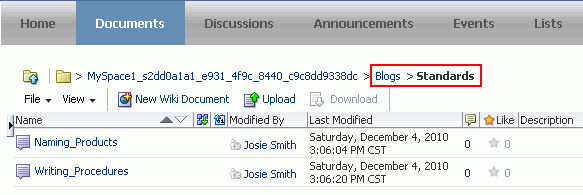
In WebCenter Spaces, the Documents service provides the blogs functionality. For the blog functionality to become available in a Space, the following requirements must be met:
Oracle Content Server 11g must be configured as the default content repository for WebCenter Spaces. WebCenter Spaces stores all blogs on Oracle Content Server 11g. The blog functionality is not available with Oracle Content Server 10g.
For information about setting up a connection to Oracle Content Server, see "Registering Content Repositories" section in Oracle Fusion Middleware Administrator's Guide for Oracle WebCenter.
The Documents service must be enabled for the Space in which you plan to create a blog. For information, see Section 51.10.1, "Enabling and Disabling Services Available to a Space."
In WebCenter Spaces, you can create and manage blogs in your Home Space and in any other Spaces on which you have the required permissions.
By default, Space members can view blogs and blog posts created by other members of a Space.
In a Space, access to a blog is controlled through the permissions granted to a role for the Documents service in the Space. For example, suppose you grant the Viewer role for a Space to a user named Monty. This assigns the View Documents permission to Monty, who can now only browse the files and folders and view blog posts in the specified Space. If you want to allow Monty to be able to create and edit blog posts, you must ensure that Monty is granted a role that has the required permissions enabled for the Documents service. For general information about roles and permissions, see Chapter 52, "Managing Space Members and Roles."
A Space moderator can control blog access by using the Set Page Access option. Page access allows users to rearrange a page, add additional widgets, and so on. It does not influence a user's access to the blog document itself, which is controlled through the Document service permissions.
Note:
In a Home Space, only the owner has access to pages. However, theauthenticated-role is automatically added for any Blog page style page that the owner creates in the Home Space (Figure 48-4). Therefore, all authenticated users can view the blogs in a user's Home Space.
For information about controlling page access, see Section 51.7.8, "Changing Access Permissions on a Space Page."
Figure 48-4 Setting Page Access for Blogs in Home Space
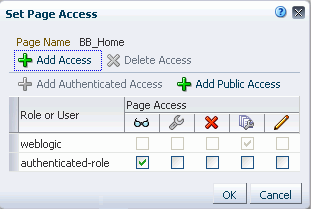
Permissions for Creating and Managing Blogs
Users can create blogs by using the Blog page style or by adding the Blogs task flow. To create and manage blogs using a Blogs task flow, users require the Create and Edit Documents permission on the Documents service.
To create and manage blogs by using the Blog page style, users require permissions on both the Documents service and the Page service.
Standard Permission Model: If this permission model is used, users require:
Create and Edit Documents permission for the Documents service (Figure 48-5).
Figure 48-5 Documents Service Permissions for Working with Blogs

Edit Page Access, Structure, and Content permission for Basic Services (Figure 48-6).
Figure 48-6 Basic Services Permission for Working with Blogs

Advanced Permission Model: If this permission model is used, users require:
Create and Edit Documents permission for the Documents service
Create Pages or Create, Edit, and Delete Pages permission for the Page service (Figure 48-7).
Figure 48-7 Page Service Permissions for Working with Blogs

Creating and Managing Blog Posts
By default, all users can create blog posts in their Home Space. To create blog posts in other Spaces, users must have the Create and Edit Documents permission for the Documents service (Figure 48-8).
All users with the permission to view documents can post comments on blog posts.
Figure 48-8 Documents Service Permissions
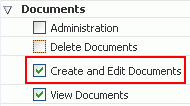
This section contains the following subsections:
In WebCenter Spaces, you can create blogs by using either of the two methods:
Creating a dedicated blog page by using the Blog page style
Creating a folder under the Blogs folder, and exposing it on a page using the Blogs task flow
This section contains the following subsections:
WebCenter Spaces provides certain default page styles to enable rapid creation of application pages. These page styles describe the positioning of content layout areas and the content flow. Out-of-the-box, WebCenter Spaces provides the Blog page style for creating a dedicated blog page.
To create a blog by using the Blog page style:
Navigate to the Space in which you want to create a blog.
From the Actions menu, select Create, then Page.
In the Create dialog, in the Page Name field, enter a display name for your blog page.
Note:
For blog pages, you must not use the following characters:\ / : [ ] * ' " |
You can use character spaces and periods (.).
From the Style options, select Blog to create a blog page (Figure 48-9).
Note:
The Blog page style becomes available in the Create dialog in a Space only if WebCenter Spaces is integrated with Oracle Content Server, and the Documents service is enabled for the Space.For information about setting up a connection to Oracle Content Server, see "Registering Content Repositories" section in Oracle Fusion Middleware Administrator's Guide for Oracle WebCenter. For information about enabling the Documents service, see Section 51.10.1, "Enabling and Disabling Services Available to a Space."
Click Create.
Figure 48-10 shows a newly created blog listed as a separate page on the top navigation bar of a Space. The location of the page in the UI depends on the page template used in your Space.
Figure 48-10 A Blog Created Using the Blog Page Style

You can choose to add blog posts to your newly created blog. For information, see Section 48.3.2, "Creating a Blog Post."
The Documents service provides various task flows that offer a different view and set of capabilities for working with documents in your content repository.
In WebCenter Spaces, you can add various service task flows, such as Discussions and Mail, on a single page. Instead of creating a dedicated blog page, you may want your blog to appear along with various other services on a page. You can do this by creating a folder for the blog, and then exposing it on a page using the Blogs task flow.
To add a Blogs task flow:
On the Documents page or in a documents task flow, create a folder under the Blogs folder.
Right-click the newly created folder, and click Properties.
From the Identifier field, copy the value (Figure 48-11).
This value is the resource ID that uniquely identifies the folder. You need to provide this resource ID in the Blogs task flow to expose the folder as a blog.
Create a page or navigate to an existing page where you want to add the blog.
From the Actions menu, select Edit Page to open the page in Oracle Composer.
Click Add Content in the target region to open the Resource Catalog.
Click Social and Communication or click the Open button next to it.
Click Add next to the Blogs task flow to add it to your page (Figure 48-12).
Click Close.
The Blogs task flow is added, and a message displays that there is no blog post in the blog (Figure 48-13).
Figure 48-13 Blogs Task Flow Added to a Page
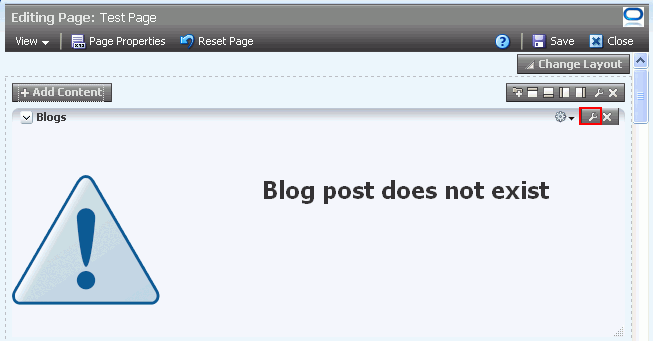
Click the Edit icon, highlighted in Figure 48-13.
In the Component Properties dialog, in the Resource Id field, paste the resource ID that you copied in step 3. Figure 48-14 shows a sample value.
Figure 48-14 Component Properties Dialog of a Blogs Task Flow
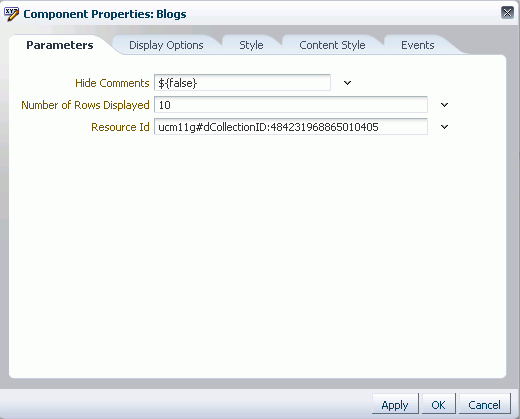
For information about the other blog properties that you can set in the Component Properties dialog, see Section 48.2.2.2, "Blogs Task Flow Parameters."
Click OK.
The Blogs task flow exposes the folder as a blog.
Figure 48-15 A Folder Exposed in a Blogs Task Flow
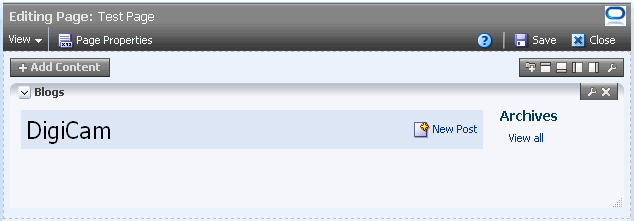
After adding a blogs task flow, you can add blog posts, as described in Section 48.3.2, "Creating a Blog Post."
The Blogs task flow and the Blog page style have associated properties, which users with sufficient privileges can access through the Component Properties dialog in Oracle Composer.
This section contains the following subsections:
The properties on the Parameters tab of the Component Properties dialog control the default task flow content. For descriptions of parameters of the Blogs task flow, see Section 48.2.2.2, "Blogs Task Flow Parameters." For description of parameters of the Blog page style, see Section 48.2.2.3, "Blog Page Style Parameters." For some task flows, parameters on this tab facilitate the wiring of the task flow to page parameters and page definition variables. For more information, see Chapter 19, "Wiring Pages, Task Flows, Portlets, and UI Components."
Changes to the properties on the Display Options, Style, and Content Style tabs affect the appearance and behavior of the task flow for all users. These properties are common to all task flows. However, the Content Style tab is not available for the Blog page style. For more information, see Section 17.5.2, "Setting Properties on Page Components."
The contents of the Events tab depend on the events supported by the task flow. For more information, see Section 17.5.2.8, "Working with Component Contextual Events."
The Child Components tab displays all of the components contained within the current component. It provides controls for rearranging, showing, and hiding child components. Not all components contain children. This tab is available for a Blog page style, but not for a Blogs task flow. For more information, see Section 17.5.2.6, "Working with Child Components."
All properties on the Parameters and Display Options tabs provide access to an Expression Language (EL) editor, which you can use to select or specify a variable value instead of a constant value. Click the Edit icon next to a property field to open the editor. For more information about using the editor and for descriptions of common EL expressions, see Appendix B, "Expression Language Expressions."
The Parameters tab displays the parameters that are unique to the Blogs task flow (Figure 48-16).
Table 48-1 describes the Blogs task flow parameters.
Table 48-1 Blogs Task Flow Parameters
| Parameter | Type | Description | Default Value |
|---|---|---|---|
|
|
Boolean |
Specify whether to display blog post comments or not:
|
|
|
|
Long |
Specify the number of rows to be displayed on the blog page. |
|
|
|
String |
The unique identifier of the selected task flow. It can be a blog folder name or a file name. If you specify a blog folder as a resource ID, all the blog post files in that folder are listed. If you specify a blog post file name, the blog post is displayed. |
None |
The Blog page style, which is a built-in page style, uses an internal task flow. The Parameters tab displays the parameters that are unique to the internal task flow (Figure 48-17).
Table 48-2 describes the parameters of the internal task flow of the Blog page style.
Table 48-2 Blog Page Style Parameters
| Parameter | Description | Default Value | |
|---|---|---|---|
|
|
Boolean |
Specify whether to display blog post comments:
|
|
|
|
String |
Do not edit this value. Shows the name of the blog exposed in the Blog page style. If you change the blog name, it does not rename your existing blog, but creates another blog and wires it to the built-in task flow. For every new name specified in For example, if you rename a blog named 'Standards' to 'StandardsChanges', a new blog named 'StandardsChanges' gets created. This blog does not contain the blog posts that were a part of the blog 'Standards'. To learn how to rename a blog, see Section 41.13, "Renaming a Folder or File"; to learn how to rename a page, see Section 29.6, "Renaming a Page." |
Page name that you specified while creating the page |
|
|
Long |
Specify the number of rows to be displayed on the blog page. |
|
|
|
String |
Do not edit this value. The unique identifier of the blog page, used internally to maintain association of the page style instance with its customization and personalization settings. |
|
Users can subscribe to be notified whenever a blog entry is posted or commented upon in a Space. Owning a blog does not automatically subscribe a blog owner to it. A blog owner must also explicitly subscribe to receive blog notifications. For information about how to subscribe to a blog, see Section 36.3.2, "Setting Space-Level Subscriptions." Whenever there is a change, you are notified through your selected messaging channel. For information about messaging channels, see Section 36.2, "Establishing and Managing Your Messaging Channels and Filters."
There is no subscription available for blogs in a Home Space. However, you can subscribe to be notified for individual blog posts in your Home Space. For information about subscribing to a specific blog post, see Section 48.3.5, "Tasks Involved in Managing Blog Posts."
This section describes how to add and manage blog posts. It includes the following subsections:
For each blog post, you can use the controls on the blog post page to perform tasks such as edit, subscribe, share, and comment upon the post (Figure 48-18). For information, see Section 48.3.5, "Managing Blog Posts."
You must keep your blog post titles unique. When you create a blog post (say Naming_Products) a file is created in the content repository with the same name as the blog post title (Naming_Products). Therefore, you cannot create two blogs posts with the same title under a blog. You can edit the content of a blog post, but not its title.
You use the Rich Text Editor (RTE) to add the content and style elements to a blog post. The RTE provides features such as the ability to embed images, create new resources on the fly, and add links. For more information, see Section 41.11, "Using the Rich Text Editor (RTE)."
By default, the entire content of a blog post gets displayed on the blog page. You can choose to display only a snippet. You can do this by using the Snippet icon in the RTE.
When you create a blog post, the blog post file is marked as a blog entry in the metadata Type field. Uploading an HTML file (which is what a blog entry is saved as when downloaded) in a blog folder does not update the Type field. Therefore, uploading HTML files in a blog folder does not expose them as blog posts.
Navigate to the blog in which you want to create a blog post.
Click New Post.
In the resulting page, in the Title field, enter a display name for the blog post (Figure 48-19).
A blog post title can be of maximum 250 characters.
In the RTE, from the Mode list, choose the desired editing mode. Add the text, formatting, styling, and links using the methods available in the selected mode in the RTE. For information about RTE toolbar icons and controls, see Table 47-2, "Rich Text Editor Toolbar Icons and Controls".
Choose a mode for publishing the blog post:
Draft: Select to mark the blog post as a draft. On a blog page, a draft blog post is marked as "Draft". Only the author of a blog post and Space moderators can view draft posts. Users with just the viewing permissions can view only published posts.
Publish: Select to publish the blog post. On a blog page, a published post is marked as "Posted".
By default, a post is published with the current date and time details. If you want the blog post to be published on a future date and time, use the date picker. The blog post will be published automatically on the specified date.
Note:
The Activity Stream shows a blog post that has a publish date, regardless of the publish date. Only draft posts are not listed in the Activity Stream.Click Create to save your changes and exit the editor.
The newly created blog post appears as the top-most entry on the blog page.
On the Document page, the newly created blog post (MyPost) is saved as a document under its parent blog folder (Office), which in turn, is stored under the Blogs folder, as shown in Figure 48-20.
Figure 48-20 Blog Posts in the Document Hierarchy

You use the RTE to add or revise the content of your blog posts.
In WebCenter Spaces, you do not need to manually check out or check in a blog post; the Documents service automatically handles this in the background. However, when you attempt to open a blog post that is already being edited by another user, WebCenter Spaces displays a message that another user has checked out the post. You can either wait until the other user finishes editing, or you can override the checkout operation by using the Cancel Check Out link and continue editing the blog post. Whenever a user saves changes, a new version of the post is created. So, effectively the last saved post appears as the current version.
To edit a blog post:
Open your blog post in edit mode in any of the following ways, depending on your view:
On the Documents page, or in a Documents service task flow, click in the row of the blog post file you want to edit, then click the Edit menu and choose Edit.
In Document Viewer in which your blog post is exposed, click the Edit button.
In the Blog page style mode or the Blogs task flow, click the Edit Post link for the required blog post.
In the Blog page style mode or the Blogs task flow, open the blog post by clicking its title, and select the Edit button on the resulting page.
In the RTE, from the Mode list, choose the desired editing mode. Add the text, formatting, styling, and links using the methods available in the selected mode in the RTE. For information about RTE toolbar icons and controls, see Section 47.3, "Rich Text Editor Toolbar Icons and Controls."
Select the Major Edit checkbox if you want to notify Space members about your changes.
Selecting this checkbox updates the Activity Stream and sends notifications after you save your changes.
Click Save to save your changes and continue editing, or click Save and Close to save your changes and exit the editor.
You can view a blog post by opening it in the Document Viewer preview pane, or by accessing the page in which the blog post resides—the page containing the Blogs task flow or the page created using the Blogs page style.
To view a blog post from the Blog page style mode or from a page that contains the Blogs task flow:
Open the required page by using the navigation bar. The way you open the page depends on the page template in use in your Space.
Click the title of the blog post.
Figure 48-21 shows a blog post in a Space that uses a top navigation page template.
Figure 48-21 Opening a Blog Post from the Blog Page Style Mode

To view a blog post in a Document Viewer preview pane:
On the Documents page or in a Documents service task flow, navigate to the Blogs folder.
Open the blog folder that contains the blog post.
Click the blog post file to open it in-place.
Figure 48-22 shows a blog post in the document hierarchy.
Figure 48-22 Opening a Blog Post in the Document Viewer Preview Pane
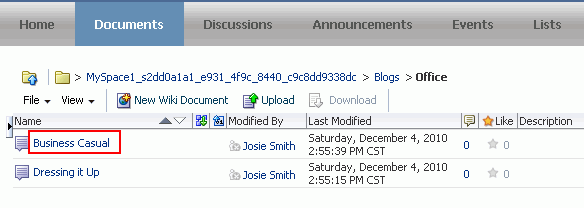
If you want to view the blog post in a separate tab in full screen mode showing only the contents of the post, choose Open in Browser from the View menu.
For more information about opening a file, see Section 41.10, "Opening a File."
The Documents service provides various features to help you manage your blog posts. Table 48-2 lists the tasks that you can perform to manage blog posts. It also lists the documentation links you can visit to know more about each task.
Note:
Some of the tasks listed in Table 48-2 can be performed by using the File menu or the View menu available in a currently open blog post, whereas some tasks can be performed by using the File menu and the View menu available on the Documents page or a Documents service task flow.Table 48-3 Tasks Involved in Managing Blog Posts
| Task | Description | Documentation |
|---|---|---|
|
You can download blog posts from the content repository to your local system. You can access the Download action from the Documents page, Documents service task flows, or the Document Viewer preview pane. The Download option is not available when you open a blog post directly from the page that contains it. Note: You can upload HTML files into your blog folder. However, the Documents service does not recognize those files as blog posts. |
||
|
Users can directly access a blog post by using its URL. You can share the link by publishing it to the Activity Stream or sending it through e-mail. The Share option is available on the File menu of a currently open blog post. |
||
|
You can subscribe to a blog post to monitor activities like when a user posts comments, updates, or deletes a blog entry. You are notified through your selected messaging channel. The Subscribe option is available on the File menu of a currently open blog post. |
Section 41.26, "Subscribing to a File" and Section 36.3.3.3, "Subscribing to a Blog Entry" |
|
|
To indicate that a blog post is of particular interest to you, you can "like" it. If a post is already liked, you can "unlike" it if you no longer wish to highlight it in any way. To like or unlike a post, use the Like icon. The icon is available when you open a blog post. The icon is also displayed next to a blog post file on the Documents page and in Documents service task flows. The number alongside the Like icon indicates the number of users who like the post. |
||
|
You can delete a blog post if it is no longer required. The Delete option is available on the File menu on the Documents page and in a Documents service task flow. |
||
|
You can rename a blog post as desired. You can rename a post by using the Rename option available on the File menu on the Documents page or in a Documents service task flow. You can also rename a blog post by using its Properties pane. |
Section 41.13, "Renaming a Folder or File" Section 41.22, "Viewing and Modifying Folder and File Properties" |
|
|
You can add tags to a blog post to specify keywords related to the content of the post to make it easily discoverable in search results. |
Section 41.19, "Working with Related Items (Tags, Links, and Recommendations)" |
|
|
You can add links to another document, note, or URL to provide a way to view, access, or associate related information. |
Section 41.19, "Working with Related Items (Tags, Links, and Recommendations)" |
|
|
Each blog post has certain associated properties, such as the read-only information about location, type, and creation and modification dates. You can use blog post properties to rename a blog post file, provide or revise a description, or obtain a reusable link to the blog post. Blog post properties are listed in the Properties pane, which you can access by clicking the Properties icon. This icon is not available when you open a blog post directly from the page that contains the post. |
Section 41.22, "Viewing and Modifying Folder and File Properties" |
|
|
You can post comments on a blog post to express your views. Use the Comments pane to add and manage comments. You can access the Comments pane by choosing Comments from the View menu on the Documents page, Documents service task flows, Document Viewer preview pane, or the blog post page in the Blog page style mode. You can also access the pane by using the Comments icon on a currently open blog post. Note: A user with view-only permissions can add comments to a blog post. |
Section 41.20, "Viewing, Entering, and Deleting Comments on a File" |
|
|
Every time you save a blog post, WebCenter Spaces saves a new version of the post and maintains the version history, available through the History pane. You can access the History pane from the Documents page, Documents service task flows, or the Document Viewer preview pane. The History pane is not accessible when you open a blog post directly from the page containing the post. |
||
|
You can specify whether you want to use custom access permissions or inherit the permissions of the parent folder for a blog post. The option to set security for a blog post is available if item level security has been enabled on Oracle Content Server. The Security option is available when you open a blog post using the Documents page or a Documents service task flow. It is not available when you open the post directly from the page that contains the post. |
Section 41.25, "Setting Security Options on a Folder or File" |
|
|
You can open or save the PDF version of the currently open blog post. This choice is available if Oracle Content Server is configured to convert blog posts to the PDF format. |